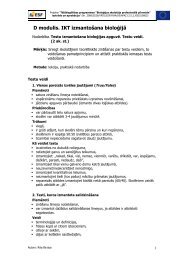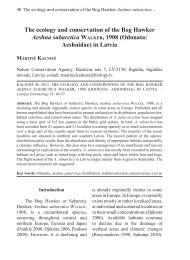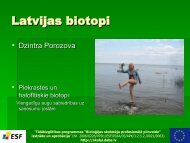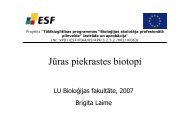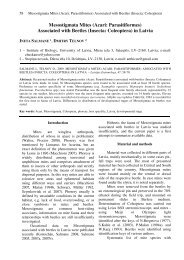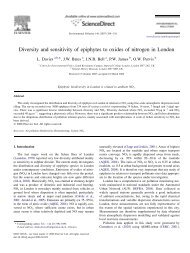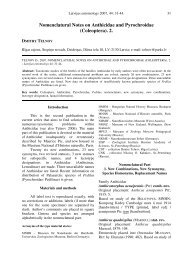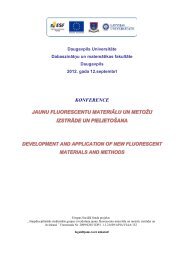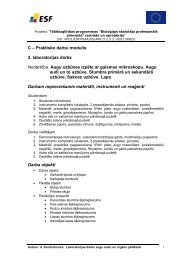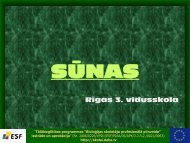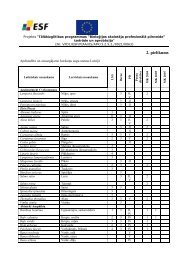Odonata - Entomological Society of Latvia - Latvijas Daba
Odonata - Entomological Society of Latvia - Latvijas Daba
Odonata - Entomological Society of Latvia - Latvijas Daba
You also want an ePaper? Increase the reach of your titles
YUMPU automatically turns print PDFs into web optimized ePapers that Google loves.
1.4. PRACTICAL IMPORTANCE OF THE STUDY<br />
Knowledge about the distribution <strong>of</strong> species is the basic information, necessary for any<br />
research. The distribution maps <strong>of</strong> the species with descriptions provide precise visual concept <strong>of</strong><br />
current and historical distribution <strong>of</strong> some species in a specific territory, changes in area and spatial<br />
distribution <strong>of</strong> populations. The distribution maps <strong>of</strong> the species together with specific maps (water<br />
body, protected territory maps etc.) improve the understanding <strong>of</strong> the variety <strong>of</strong> species in the<br />
corresponding territories. Maps may also be used to educate society.<br />
The knowledge about the spatial distribution <strong>of</strong> dragonfly imagoes according to the micro<br />
habitats and vegetation structures <strong>of</strong> oligotrophic habitats may be used in the feeding researches <strong>of</strong><br />
other animals, for example, spiders and birds (red-footed falcons and hobbies). This information<br />
may be used also in the planning <strong>of</strong> the routes <strong>of</strong> nature trails and the visiting times <strong>of</strong> these trails in<br />
raised bogs.<br />
The results <strong>of</strong> the dragonfly larvae research may be used in the investigation <strong>of</strong> the feeding<br />
ecology <strong>of</strong> salmoniformes and the impact <strong>of</strong> small hydro-power plants on the river macro zoo<br />
benthos. This information about the distribution <strong>of</strong> dragonfly larvae and the density <strong>of</strong> their<br />
population may also be used in the research <strong>of</strong> the feeding <strong>of</strong> other animals or larger food webs.<br />
Information about the distribution <strong>of</strong> rare and endangered European species and their<br />
connection to certain habitats and micro habitats can be used for the planning <strong>of</strong> the protective<br />
measures, including the use <strong>of</strong> nature resources and territory development. This knowledge may be<br />
used in planning <strong>of</strong> the routes <strong>of</strong> nature trails and the visiting times <strong>of</strong> these trails.<br />
1.5. APPROBATION OF THE RESEARCH<br />
The most important results <strong>of</strong> this dissertation have been published in twelve publications.<br />
Two more publications have been developed on dragonflies in specially protected nature territories.<br />
The results have also been reported in seven international and four local conferences, congresses<br />
and symposiums.<br />
PUBLICATIONS<br />
The main results <strong>of</strong> the study are described in the following publications<br />
Kalniņš M. 2012. Dragonflies (<strong>Odonata</strong>) <strong>of</strong> <strong>Latvia</strong> - history <strong>of</strong> research, bibliography and<br />
distribution from 18 th century until 2010. - <strong>Latvijas</strong> Entomologs 51. (Accepted.)<br />
Kalniņš M. 2012. The ecology and conservation <strong>of</strong> the Subarctic Hawker Aeshna subarctica<br />
Walker, 1908 (<strong>Odonata</strong>: Aeshnidae) <strong>of</strong> <strong>Latvia</strong>. - <strong>Latvijas</strong> Entomologs 51. (Accepted.)<br />
Kalniņš M. 2011. Correlation between the dragonfly (<strong>Odonata</strong>) community and the habitat<br />
structure in Sudas-Zviedru Bog and Lielais Ķemeru Bog <strong>of</strong> <strong>Latvia</strong>. - International Journal <strong>of</strong><br />
Odonatology. (Submitted.)<br />
Kalniņš M. 2011. The distribution <strong>of</strong> southern dragonfly (<strong>Odonata</strong>) species in <strong>Latvia</strong> and adjacent<br />
territories. - Environmental and Experimental Biology 9: 43-52.<br />
Kalniņš M., Bernard R., Miķelsone I. 2011. Protected Aquatic Insects <strong>of</strong> <strong>Latvia</strong> - Nehalennia<br />
speciosa (Charpentier, 1840) (<strong>Odonata</strong>: Coenagrionidae). - <strong>Latvijas</strong> Entomologs 50: 41-54.<br />
Kalniņš M. 2009. Lesser Emperor Anax parthenope (Sélys, 1839) (<strong>Odonata</strong>: Aeshnidae) - a new<br />
dragonfly species in <strong>Latvia</strong>. - <strong>Latvijas</strong> Entomologs 47: 16-20.<br />
Kalniņš M. 2008. Protected Aquatic Insects <strong>of</strong> <strong>Latvia</strong> - Leucorrhinia albifrons (Burmeister, 1839)<br />
and L. caudalis (Charpentier, 1840) (<strong>Odonata</strong>: Libellulidae). - <strong>Latvijas</strong> Entomologs 45: 5-13.<br />
Kalniņš M. 2007. Brown Orthetrum Orthetrum brunneum (Fonscolumbe, 1837) (<strong>Odonata</strong>,<br />
Libellulidae) a new dragonfly species in <strong>Latvia</strong>. - Acta Biologica Universitatis<br />
Daugavpiliensis 7 No. 1-2: 109-111.<br />
Kalniņš M. 2007. Protected Aquatic Insects <strong>of</strong> <strong>Latvia</strong> - Leucorrhinia pectoralis (Charpentier, 1825)<br />
(<strong>Odonata</strong>: Libellulidae). - <strong>Latvijas</strong> Entomologs 44: 24-30.<br />
Kalniņš M. 2006. An investigation <strong>of</strong> dragonfly (<strong>Odonata</strong>) ecology at the Tītmaņu oxbow, Gauja<br />
National park, <strong>Latvia</strong>. - Acta Biologica Universitatis Daugavpiliensis 6 No. 1-2: 103-108.<br />
44



